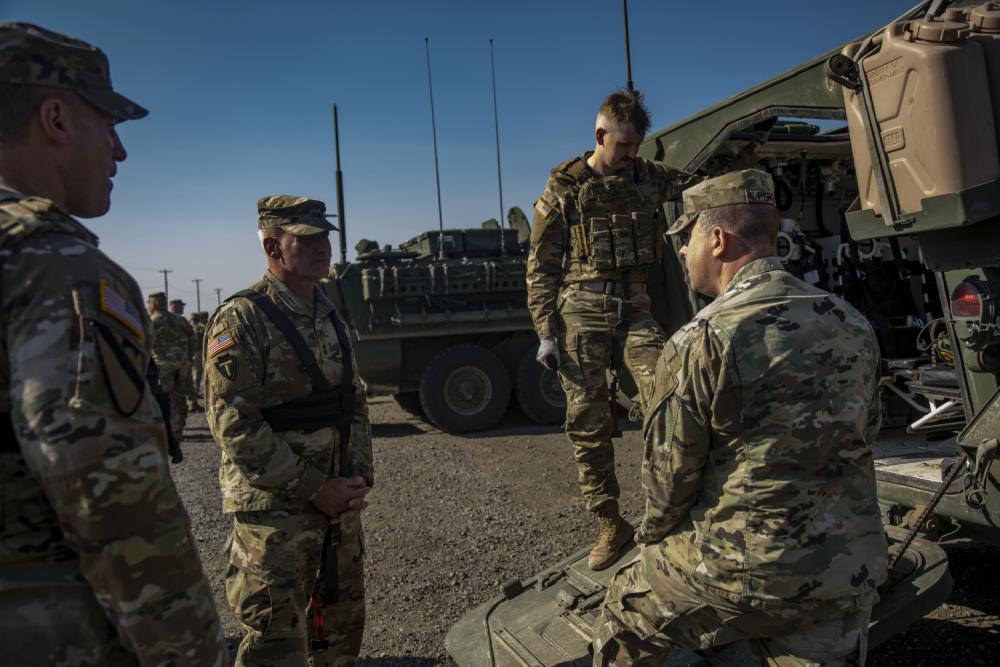Story and photo by: Joseph Siemandel

YAKIMA, Washington - Soldiers in the 81st Stryker Brigade Combat Team may be afforded new training opportunities as it moves under the 36th Infantry Division out of Texas under the U.S. Army’s new divisional alignment.
“The new divisional alignment opens opportunities to conduct warfighter exercises with habitual units, therefore building continuity and familiarity in the event of large-scale combat operations,” said Col. Matthew James, director of operations for the Washington Army National Guard.
In September, Washington Maj. Gen. Bret Daugherty signed a memorandum of agreement to facilitate unity of effort with the Adjutants General of Texas, Mississippi, Tennessee and New Mexico and the Commanding General, 36th Infantry Division. Under the MOA, which went into effect on Sept. 30, 2022, the 36th Infantry Division, Texas National Guard has coordinating authority with the Washington Army National Guard’s 81st Stryker Brigade Combat Team.
Under this alignment construct, the 36th Infantry Division constitutes nine brigades headquartered in five states: Texas, Mississippi, Tennessee, Washington, and New Mexico.
Maj. Gen. Win Burkett, the commander of the 36th Infantry Division joined Col. Jim Perrin, commander of the 81st Stryker Brigade Combat Team, to visit Guard members as they trained at the Yakima Training Center. During the visit, he got the chance to talk with soldiers about the alignment and the new opportunities.
“Unlike the Army Associated Unit Program, which was an alignment for Training Readiness Oversite to assist Brigade Combat Teams with their mission essential tasks list benchmarks, this is a true go to war alignment with emphasis not just on training but readiness across personnel, equipment, and maintenance,” said James.
The alignment brings more training, knowledge sharing and leadership development opportunities to develop high performing leaders within the participating states through the Talent Management Alignment Process. While the Adjutants General retain final approval of all positions for organic units within their states, they allow soldiers from participating states to apply for certain positions through their individual talent management processes as they become available.
The divisional alignment will better enable the Army National Guard to plan training and operations with subordinate units in different states, setting the conditions for large-scale operational readiness. It also means the Army Guard will modernize in a predictable and sustainable manner.
“[This alignment] could provide command and key developmental position opportunities within other states; it allows Washington National Guardsmen to compete for coveted positions they may not otherwise have the opportunity to compete for and it may allow for Washington National Guardsmen who live out of state to drill in a state closer to their homes,” said James.
During a panel discussion, Army National Guard leaders addressed the divisional alignment and how it will affect the National Guard. They believe this new alignment will provide soldiers and families with more predictability and lessen the impacts of the demanding implementation requirements on units. They also addressed the new reality of a global environment characterized by great power competition and how the Army is looking to best use Army National Guard Divisions within the Multi-Dominant Operations fight.
“The 36th Infantry Division is classified as a ‘Standard Heavy’ division with subordinate Armor, Stryker and Infantry Brigade Combat Teams. The Army has also defined divisions as the ‘unit of action’ with the intent of deploying division sized organizations to fight a near peer in large scale combat operations,” said Maj. Nick Stuart, G35 future operations with the Washington Army National Guard. “This is a shift from the Global War on Terrorism where Brigade Combat Teams were the unit of action.”
Currently, there is no federal deployments on the docket for the 36th Infantry Division or the 81st Stryker Brigade Combat Team.